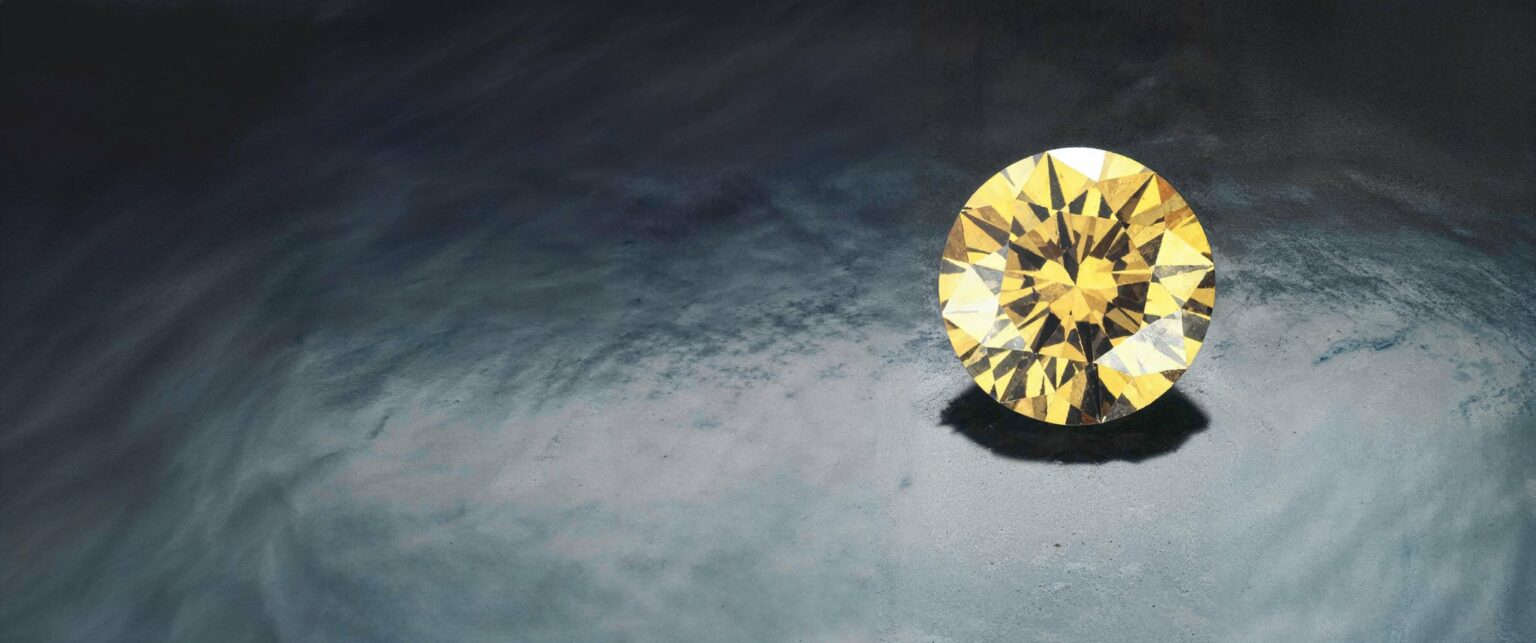Likening the color of fancy yellow diamonds to that of the canary seems to have been around forever. But in all probability, the practice is little more than a century old. Even then, we can be sure that meanings of the word “canary” as a descriptive term for diamonds have shifted considerably.
To start with, this finch-family member comes in two breeds, wild and domestic, each with distinctly different plumage colors. “Wild canaries,” the 1991 World Book informs us, “are dark green and olive-colored while “most tame canaries are bright yellow.” Thus you could very well end up arguing about exact shades of meaning for this word when it is used as a synonym for yellow.
No doubt, moderns have in mind the glowing yellow of the tame variety. But since these yellows vary from pure to orangey and match with fancy to fancy-intense stones that in mid-1992 cost from $5,000 to $50,000 per carat in 1-carat sizes, the term “canary” obviously has some latitude. To confuse matters more, it is far from certain that our forebears today have defined “canary” anywhere near the way we do today. Indeed, don’t even be sure they would have thought of comparing the yellow of a diamond to that of a canary at all.
For two reasons. First, the breakthrough breeding of one-color canaries with bright yellow plumage seems to have occurred around the time seafaring jeweler Jean-Baptiste Tavernier was making his seven voyages to Asia (1641-1667) described in his epic narrative, “Travels in India.” Although canaries became domesticated as early as the 14th century, notes the Encyclopedia Americana, it wasn’t until 1677—two years after Tavernier published his book—that “completely yellow birds” were first reported, these in Germany. Were their yellows pale or bright, pure or modified? Second, even if Tavernier and his contemporaries had seen tame canaries similar to those in homes today, it is doubtful their highly saturate color would have come to mind when looking at diamonds. The extremely few fancy yellow diamonds found in India (which produced at least 95% of the world’s diamonds until around 1730) usually were modified by either green or brown (same as the yellow of the wild canary). Fancy yellows from Brazil were as rare as ones from India and their color, too, was a far cry from the boisterous sunflower-hue commonly thought of as “canary.”
In any case, for use of the term “canary” to take hold in the diamond trade, one would have had to see both the bright-yellow variety of this bird and its diamond counterpart on a regular basis. That couldn’t have happened before 1869 and the discovery of vivid yellow diamonds in South Africa. Only if these stones could have conjured up the vibrant plumage of what was by then, thanks to selective breeding, a bright yellow songbird. Then, and only then, the stage was set for “canary” to become a diamond slang word.
Then, and only then, the stage was set for fraud as dealers and jewelers stretched “canary” to be a term of endearment for any and every yellowish diamond.
The Cape Connection
From day one, South African diamonds had a reputation for being slightly yellow. Accounts of the diamond trade written between 1880 and 1900 stress this fact. Indeed, the term “Cape” was coined to describe the distinctively yellowish—as opposed to yellow—diamonds from Kimberley that began to flood the market in the 1870s. Originally a reference to all stones of South African origin, the term “Cape” was narrowed within a decade or so to a synonym for the marring presence of yellow. Here’s what Max Bauer had to say about the term in his 1896 masterpiece “Precious Stones.”
“The majority of what are usually regarded as white Cape diamonds are in reality more or less tinged with yellow. Stones of this tint are described as being ‘Cape white.’… Such a stone scarcely attains to the fire and play of colour of a perfectly colourless Indian or Brazilian stone; moreover, even though cut in the best brilliant form, it will appear dusky when compared with the latter and will therefore be less highly prized.”
Curiously, Bauer seems to have restricted the definition of the term “Cape” to stones that have, at most, a slight cast—as opposed to a full-fledged composition—of yellow. He continues: “Stones of a distinct, though pale, yellow color are specially common; they vary in shade from a [canary or straw-yellow] to a light coffee brown, and are naturally less prized than the Cape whites or others already mentioned.”
Note that Bauer equated “canary” with “straw-yellow,” hardly the hue that comes to mind today for canaries. Today such stones are invariably fancy—preferably fancy-intense—yellow on the GIA color diamond grading scale. Yet Bauer seemed to use “canary” interchangeably with “Cape,” or at least, the light-yellow portion of the Cape series. Since “Cape” stones are ones he viewed as distinct from “fancy” stones, how did “canary” become a sobriquet for fine yellow diamonds?
Mellow Yellows
By 1900, “Cape” seems to have become a comprehensive term for all degrees of perceptible yellow in diamonds that did not render them fancy color. Stones on the border, or squarely in the realm of fancies, needed jargon of their own. In the English-speaking world however, the color-term of choice became “canary.” According to eminent gemologist Robert Crowningshield, England’s highly influential Basil Anderson used the phrase “true canary” to segregate diamonds with strong absorption spectra and correspondingly deep yellow colors from ones he called “Capes” with weaker lines and varyingly yellowish hues. When making his historic spectroscopic studies of the 1930s. The polar distinction between “Cape” and “canary” has been with us ever since. Presumably, Anderson was simply codifying what was by then a division between the two. But, apparently, the division stayed a trade secret and many retailers sold “Capes” as “canaries.”
Such abuse prompted a lawsuit against the Zale Corp. in 1989 by a woman who bought a 38-stone diamond necklace in 1974 consisting entirely of canary diamonds. Around 1986, the owner gave the necklace to her daughter, who sent it to GIA for grading. When the new owner learned that more than 75% of the necklace’s diamonds were Capes, she went to her mother, who requested but was refused a refund. The woman sued. In its defense, Zale argued that “canary” and “Cape” meant the same things, true perhaps in 1900, but certainly not true since the 1930s. Although the case was settled out of court, it should be a reminder to everyone that “Cape” and “canary” are now, and have long been, antonyms rather than synonyms.
Please note: this profile was originally published in 1992 in Modern Jeweler’s ‘Gem Profiles/2: The Second 60’, written by David Federman with photographs by Tino Hammid.
The .66-carat canary diamond shown in the header of this page is courtesy of Fancoldim Registered, Liechtenstein.






